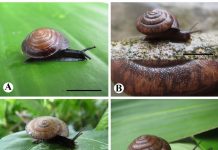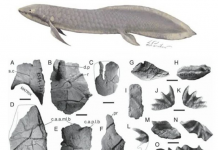Assistant Professor Dr Piyatida Pimvichai, a SCIMSU researcher from the Department of Biology at Mahasarakham University, and her colleagues published an article in Invertebrate Systematics (2018). The publication entitled “Morphological and mitochondrial DNA data reshuffle the taxonomy of the genera Atopochetus Attems, Litostrophus Chamberlin and Tonkinbolus Verhoeff (Diplopoda: Spirobolida: Pachybolidae), with descriptions of nine new species.”
Abstract: Species-level taxonomy and phylogeny of two genera of South-East (SE) Asian pachybolid millipedes are analysed with a combination of morphological characters and DNA sequences (two mitochondrial gene fragments: COI and 16S rRNA). Strong support is found for the genera Litostrophus Chamberlin, 1921 and Atopochetus Attems, 1953 and for a clade consisting of Litostrophus + Atopochetus. Four species of Litostrophus are recognised and (re)described: L. segregatus Chamberlin, 1921 (type species of the genus), L. scaber (Verhoeff, 1938), comb. nov., L. chamaeleon, sp. nov. and L. saraburensis, sp. nov. The genus Tonkinbolus Verhoeff, 1938 (type species T. scaber Verhoeff, 1938) is synonymised under Litostrophus. Atopochetus (type species A. rubropunctatus Attems, 1953), hitherto considered a dubious synonym of Aulacobolus Pocock, 1903, is re-instated for several species until now placed in Tonkinbolus and seven new species. All in all, 10 species of Atopochetus are (re)described: A. dollfusii (Pocock, 1893) (= Aulacobolus rubropunctatus Attems, 1938, syn. nov.), A. moulmeinensis (Pocock, 1893), A. sumatranus (Carl, 1906) (= Trachelomegalus laciniatus Attems, 1937, syn. nov.), A. anaticeps, sp. nov., A. helix, sp. nov., A. setiferus, sp. nov., A. spinimargo, sp. nov., A. truncatus, sp. nov., A. uncinatus, sp. nov. and A. weseneri, sp. nov. Three species recently included in Tonkinbolus are left incertae sedis because they are based exclusively on female type specimens: Spirobolus capucinus Porat, 1896, S. caudulanus Karsch, 1881 and S. macrurus Pocock, 1893. The results of the DNA analysis (COI and 16S rRNA) are congruent with morphological (gonopodal) characters in terms of delimitation of species of Litostrophus and Atopochetus. This is the first DNA study of SE Asian Pachybolidae and as such it provides a basis for further evolutionary and biogeographic studies of SE Asian millipedes.
1. Litostrophus chamaeleon Pimvichai, Enghoff, Panha & Backeljau 2018 (กิ้งกือหางมนคาเมเลี่ยน)
Holotype: Thailand, Ubonratchathani Province, Khong Chiam District, Tor-Sang Hotel, 15º 18′ 58″N, 105º 30′ 43″E, 6.xi.2010, P. Pimvichai leg. (CUMZ-D00112).
Etymology: The name is a noun in apposition (as in the scientific name of the common chameleon, Chamaeleo chamaeleon) and refers to the profile of the posterior gonopod, which somewhat looks like a chameleon sticking its tongue out.


2. Litostrophus saraburensis Pimvichai, Enghoff, Panha & Backeljau 2018 (กิ้งกือหางมนสระบุรี)
Holotype: Thailand, Saraburi Province, Putthanimit temple, 14º 38′ 23″N, 101º 08′ 59″E, 24.vi.2007, P. Pimvichai leg. (CUMZ-D00121).
Etymology: The name refers to Saraburi Province, the type locality of this species.
3. Atopochetus anaticeps Pimvichai, Enghoff, Panha & Backeljau 2018 (กิ้งกือหางมนหลังจุดส้ม)
Holotype: Thailand, Saraburi Province, Chalermprakiat District, Phukhae Botanical Garden, 14º 40′ 15″N, 100º 53′ 12″E, 31.viii.2014, P. Prasankok, T. Backeljau and P. Pimvichai leg. (CUMZ-D00122).
Etymology: The name is a Latin noun in apposition and refers to the duckheadlike profile of the posterior gonopod telopodite.

4. Atopochetus helix Pimvichai, Enghoff, Panha & Backeljau 2018 (กิ้งกือหางมนปลายเกลียว)
Holotype: Thailand, Kanchanaburi Province, Thong Pha Phum District, Suan Pa Thong Pha Phum, 14º40′ 12″N, 98º35′ 36″E, 8.v.2007, C. Sutcharit and P. Pimvichai leg. (CUMZ-D00094).
Etymology: The name is a Latin noun in apposition and refers to the helicoid tip of the posterior gonopod.

5. Atopochetus setiferus Pimvichai, Enghoff, Panha & Backeljau 2018 (กิ้งกือหางมนปลายขน)
Holotype: Thailand, Uthaithani Province, Lan-Sak District, Hub Pa Tard, 15º 22′ 37″N, 99º 37′ 50″E, 27.v.2012, S. Panha and P. Pimvichai leg. (CUMZ-D00097).
Etymology: The species epithet is a Latin adjective, meaning bearing setae, and refers to the structure of the meso-distad process.
6. Atopochetus spinimargo Pimvichai, Enghoff, Panha & Backeljau 2018 (กิ้งกือหางมนสงขลา)
Holotype: Thailand, Songkhla Province, Rattaphum District, Charoen Phupha temple, 7º 08′ 54″N, 100º 15′ 35″E, 12.i.2009, S. Panha and P. Pimvichai leg. (CUMZ-D00099).
Etymology: The name is a Latin noun in apposition and refers to the spined mesal margin of the posterior gonopod telopodite.
7. Atopochetus truncatus Pimvichai, Enghoff, Panha & Backeljau 2018 (กิ้งกือหางมนสิมิลัน)
Holotype: Thailand, Phang Nga Province, Khuraburi District, Koh 8, Similan islands, 8º 39′ 09″N, 97º 38′ 27″E, 7.iv.2010, S. Panha and P. Pimvichai leg. (CUMZ-D00101).
Etymology: The name refers to the truncate posterior gonopod tip.

8. Atopochetus uncinatus Pimvichai, Enghoff, Panha & Backeljau 2018 (กิ้งกือหางมนเทาขาแดง)
Holotype: Thailand, Phetchaburi Province, Khao Yoi District, Khao Yoi, 13º 14′ 03″N, 99º49′ 35″E, 22.viii.2014, P. Prasankok, T. Backeljau and P. Pimvichai leg. (CUMZ-D00103)
Etymology: The species epithet is a Latin adjective and refers to the hook-like process at the tip of the posterior gonopod.
9. Atopochetus weseneri Pimvichai, Enghoff, Panha & Backeljau 2018 (กิ้งกือหางมนแดงส้ม)
Holotype: Thailand, Suratthani Province, Koh Samui District, Koh Mae Koh, 9º 39′ 19″N, 99º 39′ 58″E, 6.vi.2009, S. Panha leg. (CUMZD00128).
Etymology: This species is named after Thomas Wesener in recognition of his work on the Pachybolidae of Madagascar.

Piyatida Pimvichai, Henrik Enghoff, Somsak Panha, and Thierry Backeljau “Morphological and mitochondrial DNA data reshuffle the taxonomy of the genera Atopochetus Attems, Litostrophus Chamberlin and Tonkinbolus Verhoeff (Diplopoda: Spirobolida: Pachybolidae), with descriptions of nine new species,” Invertebrate Systematics 32(1), 159-195, (1 February 2018). https://doi.org/10.1071/IS17052







